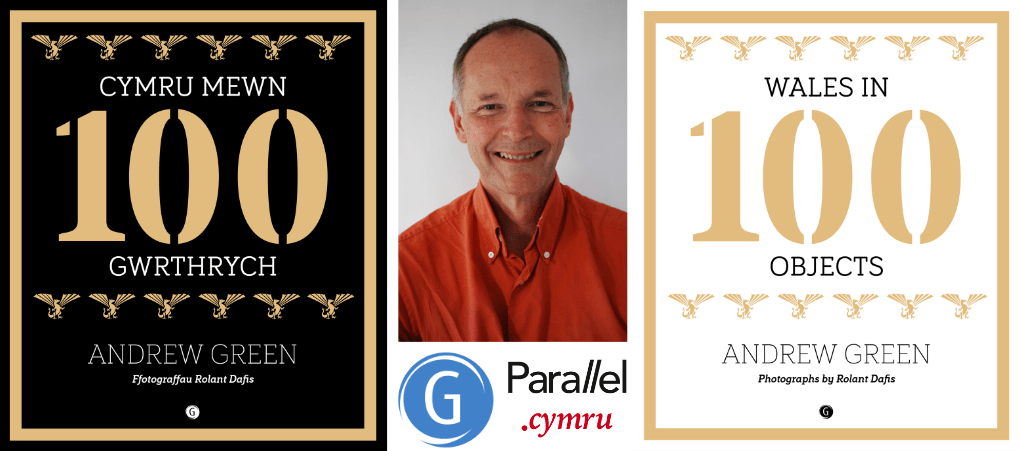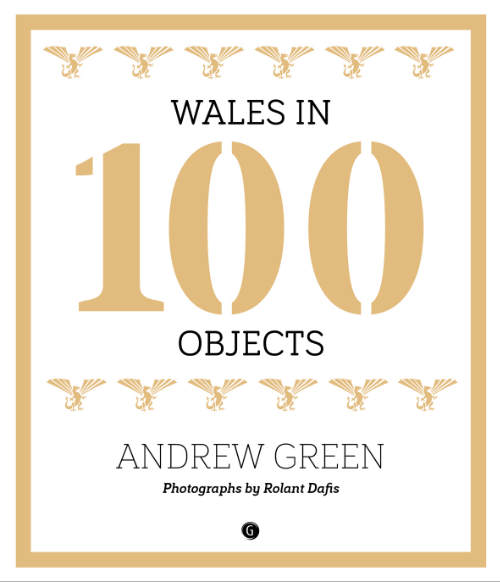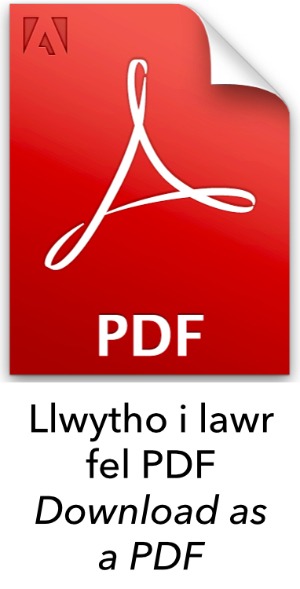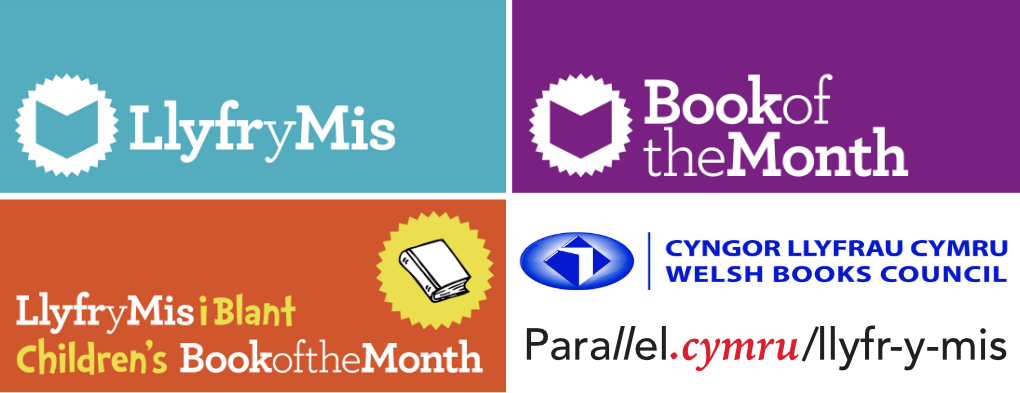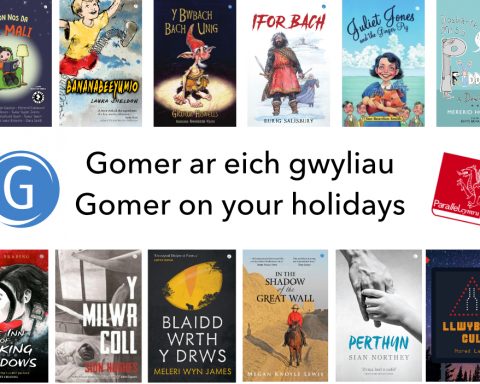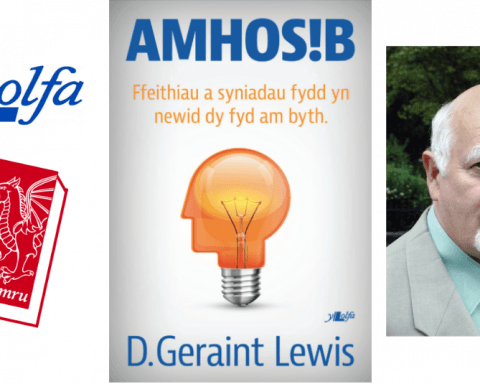Mewn llyfr unigryw, mae cyn-Brif Lyfrgellydd Llyfrgell Genedlaethol, Andrew Green, yn rhannu hanes Cymru mewn 100 o wrthrychau. Yn ddiddorol, mae dau fersiwn o'r llyfr- un yn y Gymraeg, ac un yn y Saesneg, ac yn Hydref 2018 cipiodd y ddau'r wobr Llyfr y Mis, yn Gymraeg a Saesneg yn eu tro. Yma, mae'n esbonio mwy am greu'r llyfrau a chyflwyno tri gwrthrych...
In an unique book, the previous Head Librarian of the National Library of Wales, Andrew Green, shares the history of Wales in 100 objects. Interestingly, there are two versions of the book- one in Welsh, and one in English, and in October 2018 both took the Book of the Month award, in Welsh and English respectively. Here, he explains more about creating the books and presents three objects...
| Beth yw ‘hanes’? Sut ydyn ni’n cael gwybod amdano? | What is ‘history’? How do we get to know about it? |
| Y ffordd arferol o siarad neu ysgrifennu am hanes Cymru, mewn llyfr neu mewn rhaglen deledu neu mewn gwers ysgol, yw trwy greu naratif: un stori drefnus sy’n gosod allan beth ddigwyddodd, yn ôl y dystiolaeth, yn y gorffennol. | The conventional way of talking about the history of Wales, or writing about it, in a book or television programme or school lesson, is by creating a narrative: a single, neat story that lays out what happened in the past, in accordance with the evidence. |
| Ond mae ffordd arall: cyfarfod â hanes wyneb yn wyneb trwy edrych ar y pethau go iawn sydd wedi goroesi o’r gorffennol ac sydd i’w gweld mewn amgueddfeydd, archifau, lyfrgelloedd a lleoedd eraill. A gofyn cwestiynau amdanyn nhw. Dwy fantais sydd i’r ffordd hon o wneud hanes. Yn gyntaf, gallwch chi deimlo’r wefr o weld (ac weithiau clywed neu hyd yn oed cyffwrdd) gwrthrych oedd yn perthyn unwaith i bobl yn y gorffennol, ddegawdau neu ganrifoedd yn ôl. Ac yn ail, trwy wneud peth ymchwil ar y gwrthrych, gallwch chi ddilyn sawl trywydd a chreu sawl naratif gwahanol, nid dim ond un yn unig, am hanes. | But there is another way: confronting history face to face, by looking at real things that have survived from the past and are to be seen in museums, archives, libraries and other places. And asking questions about them. There are two advantages to this way of doing history. The first is that you can feel the thrill of seeing (and sometimes hearing or even touching) an object that once belonged to people in the past, decades or centuries ago. And second, by doing a bit of research on the object, you can follow a number of different trails and create several historical narratives, rather than just a single one. |
| Erbyn hyn mae nifer o lyfrau sy’n dwyn y teitl ‘XXX mewn 100 gwrthrych’, ond y llyfr gwreiddiol – y tad-cu ohonyn nhw i gyd – yw The World in 100 Objects gan Neil MacGregor. Fy syniad, dros dair blynedd yn ôl, oedd paratoi cyfrol debyg fyddai’n trin sawl agwedd ar hanes Cymru trwy’r oesoedd. Cyfres o gyflwyniadau radio oedd sail llyfr Neil MacGregor, felly mae’r testunau’n hir, a’r llyfr hefyd – dros 700 tudalen. | Today there are several books with the title ‘XXX in 100 objects’, but the original book – the grandad of them all – is Neil MacGregor’s The World in 100 Objects. My idea, over three years ago, was to prepare a similar volume that would deal with aspects of Welsh history through the ages. Neil MacGregor’s book was based on a series of radio broadcasts, so the texts were lengthy, and the book too – over 700 pages. |
| Anelais i at destunau mwy cyfyng, a chyfrol lai. Ac roedd gwahaniaeth arall: daeth gwrthrychau MacGregor o’r un sefydliad, yr Amgueddfa Brydeinig. Roeddwn i am gynnwys pethau o sawl math o sefydliad – archifau a llyfrgelloedd yn ogystal ag amgueddfeydd – a hynny ar draws Cymru. Yn anochel mae llawer yn dod o Amgueddfa Cymru a Llyfrgell Genedlaethol Cymru, fel y casgliadau cyfoethocaf, ond dwi wedi cynnwys pethau o dros ddeugain o sefydliadau lleol ledled y wlad. | I aimed at more economical texts and a shorter book. There was another difference: MacGregor’s objects came from the same institution, the British Museum. I wanted to include things from many types of institution – archives and libraries as well as museums – and from across Wales. Inevitably many of them come from Amgueddfa Cymru – National Museum Wales and the National Library of Wales, as the richest collections, but I’ve included objects from over forty local institutions scattered across the country. |
| Mae dethol can gwrthrych, wrth gwrs, yn ddewis amhosibl, er imi geisio taro cydbwysedd o ran amser (pethau o bob oes, o’r Neanderthaliaid hyd heddiw), daearyddiaeth (pethau o bob cwr o Gymru) a phwnc (popeth o deganau i arfau). Bydd y llyfr wedi llwyddo os yw’n ysgogi darllenwyr i ofyn iddyn nhw eu hunain, ‘beth fyddwn i’n eu dewis fel fy hoff gant | Selecting 100 objects, of course, has been an impossible choice, though I tried to strike a balance as regards time (objects from all periods, from Neanderthals to now), geography (objects from all over Wales) and subject (everything from toys to weapons). The book will have succeeded if it prompts readers to ask themselves the question, ‘what would I choose as my top 100?’. |
| Dyma ddetholiad o dri gwrthrych yn y llyfr, o wahanol gyfnodau. | Here is a small sample of three of the objects in the book, widely spaced in time. |
Gwrthrych 14: Carreg Voteporix / Voteporix stone
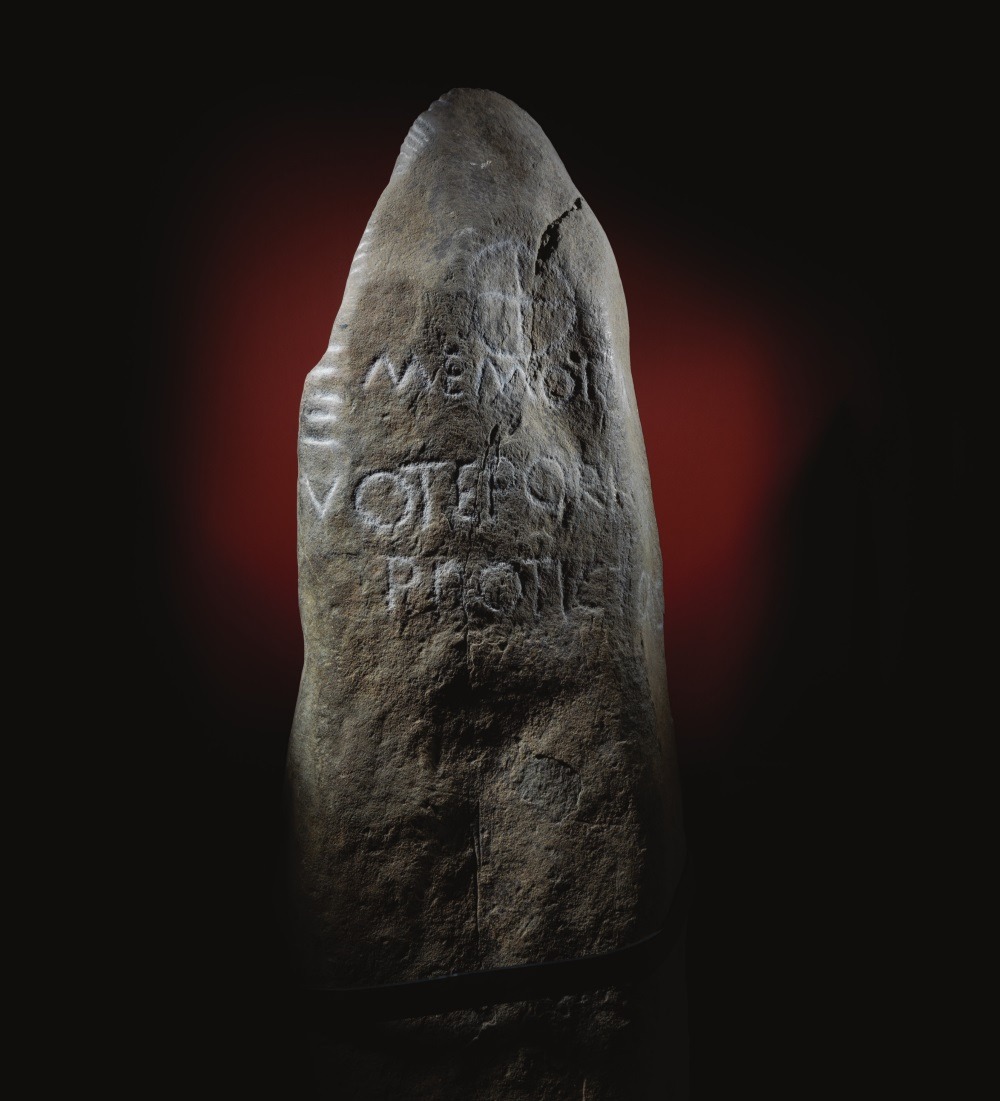
Carreg eithaf amrwd yw hon, yn Amgueddfa Sir Gâr, ond mae’n cynnig llawer o wybodaeth am oes sy’n ‘dywyll’ inni heddiw – y canrifoedd ar ôl i’r Rhufeinwyr adael Cymru ar ddechrau’r bumed ganrif. Mae’n dod o Gastell Dwyran yn Sir Gaerfyrddin ac yn coffáu arweinydd o’r enw Voteporix.
Lladin yw iaith y geiriau ar flaen y garreg: ‘memoria Voteporix protictor’, hynny yw, ‘cofeb Voteporix, gwarchodwr’. ‘Protictor’ oedd teitl anrhydeddus yn yr ymerodraeth Rufeinig hwyr: yn amlwg roedd Voteporix yn gweld ei hun fel etifedd o’r hen drefn Rufeinig, er bod ei enw yn Frythonig - yr iaith y tyfodd Cymraeg ohoni. Ar ymyl y garreg, fodd bynnag, mae rhicynnau ‘ogam’ – geiriau mewn gwyddor Wyddeleg sy’n rhoi ei enw fel ‘Votecorigas’, sef ffurf Wyddeleg. Mae’n ymddangos fod Voteporix yn perthyn i bobl, y Déisi, a fu’n mewnfudo i dde-orllewin Cymru o dde-ddwyrain Iwerddon yn ystod y canrifoedd blaenorol.
Ffigwr trothwyol oedd Voteporix, felly: Brython, o dras Wyddelig, ond yn ymwybodol o hanes Rhufeinig ei wlad, oedd yn byw, o bosibl tua chanol y chweched ganrif, pryd roedd cymdeithas nodweddiadol Gymreig yn dechrau ymffurfio (mae Castell Dwyran yn agos i Arberth, prif lys tywysogaeth Dyfed).
It’s quite a crude stone, this (now in Carmarthenshire Museum), but it gives us a lot of information about an age that appears ‘dark’ to us – the centuries after the Romans left Wales at the start of the fifth century. It comes from Castell Dwyran in Carmarthenshire and commemorates a leader called Voteporix.
The words on the front of the stone are in Latin: ‘memoria Votepoirix protictor’, that is, ‘the memorial of Voteporix, protector’. ‘Protictor’ was an honorific title used in the late Roman empire: clearly Voteporix saw himself as an inheritor of the old Roman order, though his own name is Brythonic – the language Welsh grew from. On the side of the stone, though, are ‘ogham’ notches – words in an Irish alphabet that give his name as ‘Votecorigas’, an Irish form. It seems that Voteporix belonged to the Déisi, a people who had migrated from south-east Ireland to south-west Wales in earlier centuries.
Voteporix was a transitional figure: a Briton, of Irish descent, but conscious of his country’s Roman past, who lived, possibly around the middle of the sixth century, when a characteristically Welsh society was beginning to form (Castell Dwyran is near Narberth, the main court of Dyfed).
Gwrthrych 45: Map o deithiau Howell Harris / Map of Howell Harris’s travels
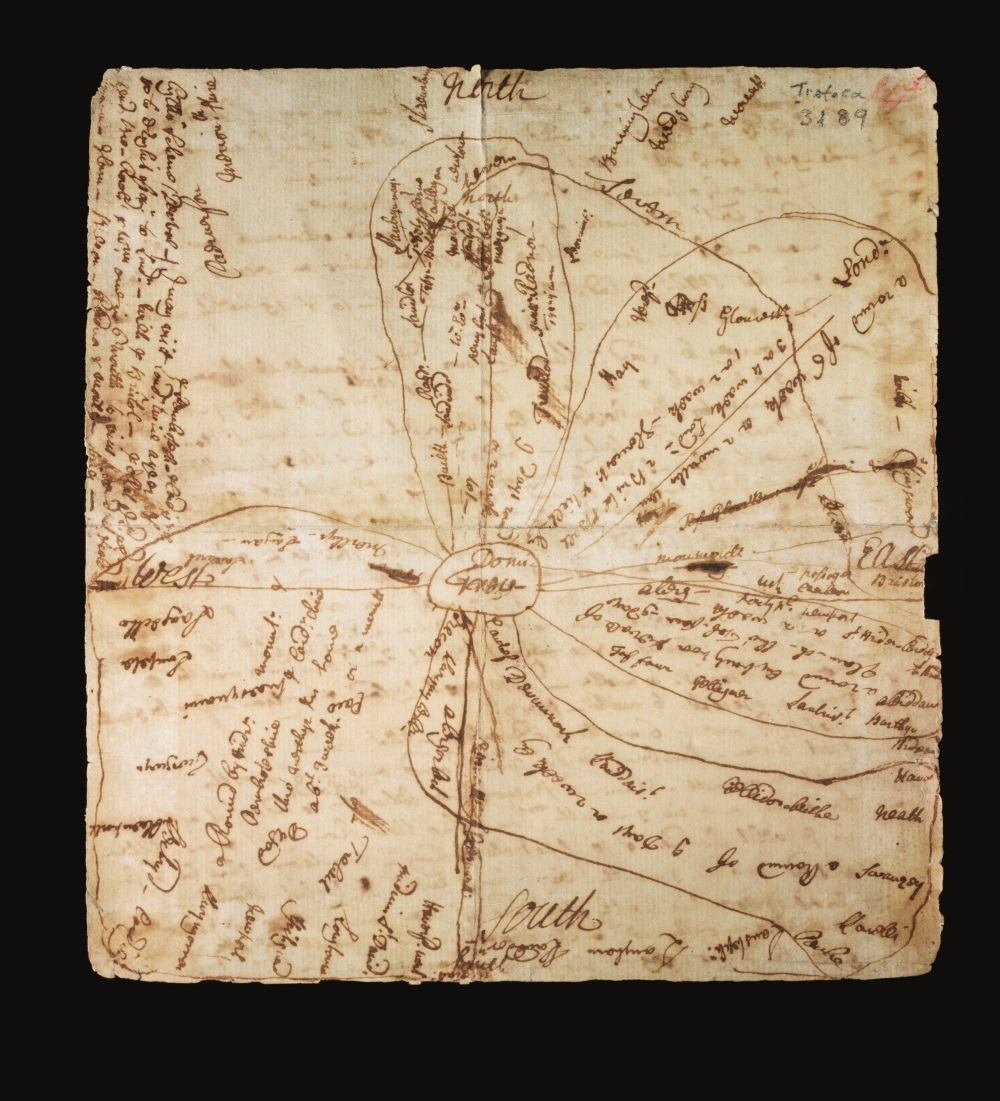
Pregethwr o Drefeca, Sir Frycheiniog, oedd Howell Harris, ac yn un o’r bobl ddylanwadol oedd yn gyfrifol am dyfiant y mudiad anghydffurfiol yng Nghymru yn y ddeunawfed ganrif. Yn 1735 cafodd e dröedigaeth grefyddol yn eglwys Talgarth, a phenderfynu mynd ar daith ddiderfyn trwy Gymru a thu hwnt i ledaenu ei neges efengylaidd. Dyma fap o Lyfrgell Genedlaethol Cymru, yn ei ysgrifen ei hun, o rai o’i deithiau. Mae’n hynod anodd darllen y geiriau, ond gellir adnabod rhai o’r enwau lleoedd: Llanbedr Pont Steffan, Llangeitho, Tyddewi, Hwlffordd, Amwythig, Birmingham a Llundain.
Yn ystod ei deithiau byddai Harris yn cadw dyddiadur manwl, mewn 284 cyfrol, ac anfon miloedd o lythyrau. Yn 1748 mae’n cofnodi, ‘ymwelais erbyn hyn [o fewn naw wythnos] â 13 o siroedd a theithio tua 150 milltir bob wythnos, a siarad ddwywaith y dydd, ac weithiau dair a phedair gwaith y dydd; ac ar y daith ddiwethaf hon dwi heb dynnu fy nillad am 7 noson’. Roedd yn ddyn anodd, obsesiynol a surbwch. 'Roedd gen i demtasiwn i chwerthin neithiwr', ysgrifennodd yn ei ddyddiadur.
Ar ôl deng mlynedd roedd Harris wedi blino’n lân, ac yn y pen draw aeth e nôl i Drefeca yn 1752. Yno sefydlodd gymuned grefyddol. Bu i’r ‘Teulu', fel y'i galwodd, 29 o aelodau erbyn 1753 a 120 yn 1763. Dros amser codwyd yn Nhrefeca gapel, becws, gerddi, ysbyty a hyd yn oed wasg argraffu.
Howell Harris, a native of Trefeca in Brecknockshire, was a preacher, and one of the influential people responsible for the growth of the nonconformist movement in Wales in the eighteenth century. In 1735 he experienced a religious conversion in Talgarth church and decided to set out on a continual tour through Wales and beyond to spread his evangelical message. His hand-written map, in the National Library of Wales, shows some of his journeys. It’s very hard to read his words, but some of the place-names can be made out: Lampeter, Llangeitho, St Davids, Haverfordwest, Shrewsbury, Birmingham and London.
In the course of his travels Harris kept a detailed diary, in 284 volumes, and sent thousands of letters. In 1748 he records, ‘I have now visited [in nine weeks] 13 Counties & travaild mostly 150 Miles every week, & Discoursed twice every Day, & sometimes three & four times a Day; & this last Journey I have not taken off my Cloaths for 7 Nights.’ He was a difficult, obsessional and surly man. ‘I had a temptation to laugh last night’, he wrote in his diary.
After ten years Harris was worn out. In the end he retreated to Trefeca in 1752. There he set up a religious community. The ‘Family’, as it was called, had 29 members by 1753 and 120 in 1763. Over time a chapel was built in Trefeca, along with a bakehouse, gardens, a hospital and even a printing press.
Gwrthrych 82: Dwy ddol syffragét / Two suffragette dolls

Eleni dyn ni’n nodi canmlwyddiant y ddeddf yn 1918 a roddodd i rai merched yr hawl i bleidleisio mewn etholiadau cyffredinol am y tro cyntaf. Yng Nghymru roedd y mudiad gan ferched i alw am y bleidlais yn gryf. Codwyd y sefydliad etholfraint cyntaf yn y wlad yn Llandudno ym mis Ionawr 1907. Fe’i dilynwyd yn gyflym gan dros 30 sefydliad arall. Erbyn 1912 Cymdeithas Etholfraint i Ferched Caerdydd a'r Cylch oedd y grŵp lleol mwyaf y tu allan i Lundain.
Un o arweinwyr mwyf radical y mudiad oedd y wraig fusnes Margaret Haig Mackworth, yn ddiweddarach y Fonesig Rhondda, a sefydlodd gangen Casnewydd y WSPU (Women’s Social and Political Union. Yn 1913 cafodd hi ddedfryd carchar am roi llythyrau ar dân mewn blwch post yng Nghasnewydd. Fe'i rhyddhawyd ar ôl mynd ar streic newyn, tacteg gyffredin gan y swffragetiaid.
Ond roedd llawer yn erbyn newid – hyd yn oed rhai merched, a sefydlodd y Gynghrair Genedlaethol yn erbyn yr Etholfraint i Ferched yn 1908. Dyma ddwy ddol, o Amgueddfa Cymru, sy’n dod allan o’r ymgyrch i atal y mudiad dros estyn etholfraint. Enw un yw ‘Miss Flora Copper’ (‘floor a copper’): gwraig ddosbarth canol ag addysg dda, agwedd benderfynol a baner sy’n dangos ei hamcan yn glir. Mae hi’n gwisgo lliwiau’r swffragét o borffor, gwyn a gwyrdd. Pêl ping-pong yw pen y llall. Mae gwep ddrwg ar ei hwyneb, a hen ddillad amdani. Yn waeth, gosodwyd pinnau i’w phen a'i chorff, fel pe bai mewn defod fwdw.
Mae’r ddwy ddol yn tystio i gryfder y teimladau ymhlith gwrthwynebwyr i’r etholfraint.
This year we celebrate the centenary of the 1918 law that gave some women the right to vote in general elections for the first time. In Wales the women’s movement calling for the vote was strong. The first Welsh suffrage organisation was founded in Llandudno in January 1907, and it was followed quickly by over thirty other societies. By 1912 the Cardiff and District Women’s Suffrage Society was the largest local group outside London.
One of the most radical leaders of the movement was the businesswoman Margaret Haig Mackworth, later Lady Rhondda, who founded the Newport branch of the Women’s Social and Political Union (WSPU). In 1913 she received a gaol sentence for setting fire to letters in a Newport post box. She was released after going on hunger strike, a common suffragette tactic.
But many people opposed suffrage – even some women, who established the National League against Women’s Suffrage in 1908. The two dolls, from Amgueddfa Cymru – National Museum Wales, come out of the campaign to stop the suffrage movement. One of them has a name, ‘Miss Flora Copper’ (‘floor a copper’): a middle-class woman with a good education, a determined attitude and a banner that proclaims her cause. She wears the suffragette colours of purple, white and green. The other has a ping-pong ball for a head. She grimaces, and her clothes have seen better days. Worse, pins have been stuck into her head and body, as if in a voodoo rite.
The two dolls bear witness to the strength of feeling among opponents of the suffrage cause.
Bywgraffiad Andrew / Andrew's Biography
Magwyd Andrew yn Swydd Efrog, a symud i Gymru yn y 1970au, gan ddechrau dysgu Cymraeg yn yr 1980au. Bu'n llyfrgellydd mewn prifysgolion yn Aberystwyth, Caerdydd, Sheffield ac Abertawe cyn dod yn Llyfrgellydd Llyfrgell Genedlaethol Cymru yn 1998. Ers ymddeol yn 2013 mae'n awdur a blogiwr wythnosol (gwallter.com), a cherddwr brwd.
Andrew was brought up in Yorkshire. He moved to Wales in the 1970s and began learning Welsh in the 1980s. He worked as a university librarian in Aberystwyth, Cardiff, Sheffield and Swansea before becoming Librarian of the National Library of Wales in 1998. Since retiring in 2013 he's been an author and weekly blogger (gwallter.com), and enjoys long-distance walking.

